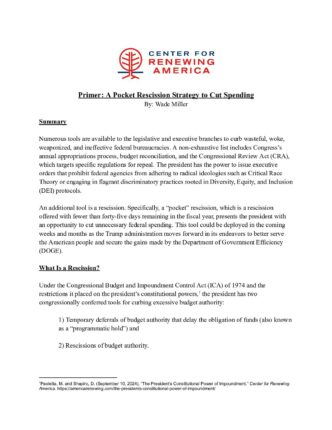
Primer: A Pocket Rescission Strategy to Cut Spending

A rescission is a viable tool for carrying out the broader political mandate to curb unnecessary spending. If the executive branch decides to use this process, the deployment of a rescission with fewer than forty-five days remaining in the fiscal year is a statutorily and constitutionally valid strategy.
Summary
Numerous tools are available to the legislative and executive branches to curb wasteful, woke, weaponized, and ineffective federal bureaucracies. A non-exhaustive list includes Congress’s annual appropriations process, budget reconciliation, and the Congressional Review Act (CRA), which targets specific regulations for repeal. The president has the power to issue executive orders that prohibit federal agencies from adhering to radical ideologies such as Critical Race Theory or engaging in flagrant discriminatory practices rooted in Diversity, Equity, and Inclusion (DEI) protocols.
An additional tool is a rescission. Specifically, a “pocket” rescission, which is a rescission offered with fewer than forty-five days remaining in the fiscal year, presents the president with an opportunity to cut unnecessary federal spending. This tool could be deployed in the coming weeks and months as the Trump administration moves forward in its endeavors to better serve the American people and secure the gains made by the Department of Government Efficiency (DOGE).
What Is a Rescission?
Under the Congressional Budget and Impoundment Control Act (ICA) of 1974 and the restrictions it placed on the president’s constitutional powers,1 the president has two congressionally conferred tools for curbing excessive budget authority:
1) Temporary deferrals of budget authority that delay the obligation of funds (also known as a “programmatic hold”) and
2) Rescissions of budget authority.
When the president determines that all or part of any budget authority is not necessary to achieve the objectives or scope of a program, he may transmit a message to Congress proposing the amount of budget authority to be rescinded or reserved. Section 1012 of the ICA requires this message to contain the specific project, program, and agencies involved, as well as the rationale, fiscal impact, and circumstances leading to the rescission request.2 The rescission is considered a privileged message, meaning Congress may consider it under an expedited process.
Since the passage of the ICA, rescissions have been used, but not widely. President Ronald Reagan had the most success with this mechanism during the first half of his first term when Congress implemented roughly 65 percent of his rescissions requests, totaling more than $15.2 billion in spending reductions in 1981–82.3 For the remaining six years of his presidency, however, more than 75 percent of Reagan’s rescissions messages were rejected or ignored by Congress, resulting in just $400 million in reduced budget authority.4
Since 1989, Congress has implemented only $5.97 billion in spending reductions from presidential rescissions requests.5 Neither the George W. Bush administration nor the Obama administration submitted a single rescission request.6 In 2018, the Trump administration proposed the largest single rescission request on record to that point, totaling more than $15 billion, with much of it aimed at reducing spending that was either duplicative or whose authority had already lapsed.7 This rescission bill passed the House of Representatives but died in the Senate.8 The Trump administration later proposed another rescissions package that totaled more than $27 billion.9 That package was summarily ignored by the incoming Democrat-controlled Congress.
How Do Rescissions Work?
Under the ICA, a rescissions message opens a forty-five-day window for Congress to pass a bill rescinding all or some of the amount proposed in the president’s message. These forty-five days are calculated based on consecutive days of session, meaning that if Congress goes into recess, those days in recess do not count as part of the window.
The ICA allows the executive branch to withhold the budget authority for the spending it has identified in its message through the entirety of the forty-five-day window. Under a rescission, if Congress chooses not to act on the message, the budget authority continues without any spending reductions following the expiration of the forty-five-day window.
Messages are one-and-done; a second rescissions message identifying the same programs may not be made once that window has passed.10
What Is a “Pocket” Rescission?
A “pocket” rescission is a standard rescission, similar to the process described above, that occurs when the president sends his rescission message to Congress with fewer than forty-five days left in the fiscal year (which ends on September 30) and then opts to withhold or pause the obligations within the message. Importantly, in this instance, the fiscal year ends before the forty-five-day statutory period for the executive branch to withhold the obligations expires. Therefore, any budget authority for funds that expires at the end of the fiscal year within the rescission lapses automatically. Congress may take up the rescission message and vote to rescind the authority or even vote to affirmatively continue the obligations. Regardless, should the executive branch continue to withhold the budget authority, which it has the statutory power to do for the full forty-five-day window, the proposed spending reductions will take effect.
This approach is rare but not unprecedented. The use of a pocket rescission has occurred before and remains consistent with the ICA.
In 1975, President Gerald Ford sent a rescissions message to Congress within days of the end of the fiscal year.11 As outlined in a letter that Director of the Office of Management and Budget Russell Vought sent to House Budget Chairman John Yarmuth in 2021, the Government Accountability Office (GAO) confirmed that $10 million in Ford’s rescission proposal had lapsed and provided a detailed explanation of what the GAO saw as a flaw in the statutory language of the ICA:
In our opinion, having to wait 45 days of continuous session before it can be determined that a proposed rescission has been rejected is a major deficiency in the Impoundment Control Act. We believe Congress should have available affirmative means within the Act to handle rescissions, aside from merely waiting for the time to pass. Examples of affirmative means could include the following: changing the Act to allow a rescission resolution as is now allowed for deferrals, or changing the Act to prevent funds from lapsing where the 45-day period has not expired. In the case of two recent rescission proposals, Congress was unable, under the Act, to reject the rescission in time to prevent the budget authority from lapsing.12
Congress has the power to follow GAO’s recommendation, but in the last fifty years, it has not chosen to amend the ICA.
Conclusion
As the White House pushes forward on revitalizing Article II impoundment authority, one of the key mechanisms created by Congress within the ICA provides an interim strategy for curbing unnecessary spending. A rescission is a viable tool for carrying out the broader political mandate to curb unnecessary spending. If the executive branch decides to use this process, the deployment of a rescission with fewer than forty-five days remaining in the fiscal year is a statutorily and constitutionally valid strategy.
Endnotes
1. Paoletta, M. and Shapiro, D. (September 10, 2024). “The President’s Constitutional Power of Impoundment,” Center for Renewing America. https://americarenewing.com/the-presidents-constitutional-power-of-impoundment/
2. Saturno, J. (February 25, 2025). “The Impoundment Control Act of 1974: Background and Congressional Consideration of Rescissions,” Congressional Research Service. https://www.congress.gov/crs-product/R48432
3. Letter to the Senate Committee on Appropriations (July 16, 2020). “Updated Rescission Statistics, Fiscal Years 1974-2020,” U.S. Government Accountability Office. https://www.gao.gov/assets/b-330828-d21941.pdf
4. Ibid.
5. Ibid.
6. Ibid.
7. Liu, E. (May 14, 2018). “Judicial Review of Rescissions and Deferrals Under the Impoundment Control Act,” Congressional Research Service. https://sgp.fas.org/crs/misc/LSB10132.pdf
8. H.R. 3 (June 20, 2018). “Spending Cuts to Expired and Unnecessary Programs Act,” Congress.Gov. https://www.congress.gov/bill/115th-congress/house-bill/3/all-actions
9. Office of Management and Budget (January 14, 2021). “Notice of Rescissions,” Federal Register. https://www.federalregister.gov/documents/2021/01/22/2021-01328/rescission-proposals-pursuant-to-the-congressional-budget-and-impoundment-control-act-of-1974
10. Saturno, J. (February 25, 2025). “The Impoundment Control Act of 1974: Background and Congressional Consideration of Rescissions,” Congressional Research Service. https://www.congress.gov/crs-product/R48432
11. Director Russell Vought (January 19, 2021). “Response Letter to House Budget Committee Investigation,” Office of Management and Budget. https://trumpwhitehouse.archives.gov/wp-content/uploads/2021/01/Response-to-House-Budget-Committee-Investigation.pdf
12. Office of the Comptroller General (December 15, 1975). “Status of Impoundment Report,” Government Accountability Office. https://www.gao.gov/assets/acg-76-12.pdf





